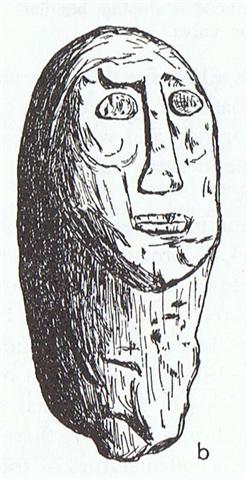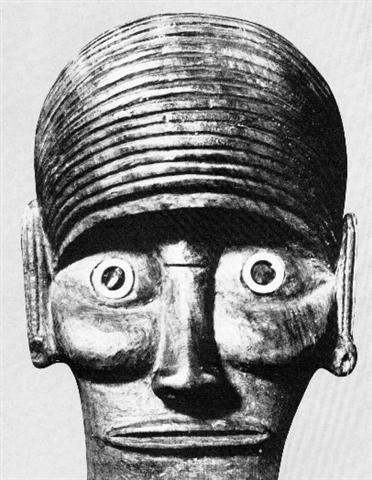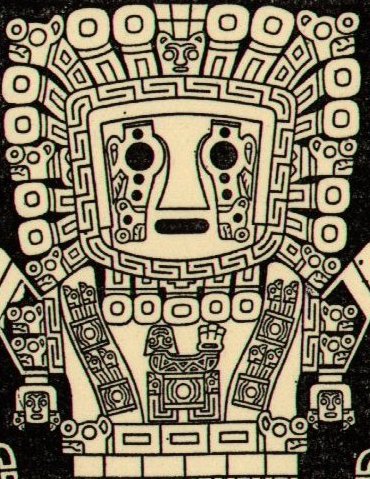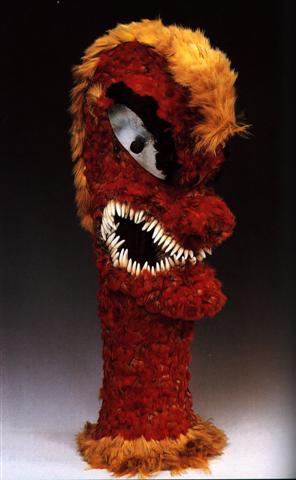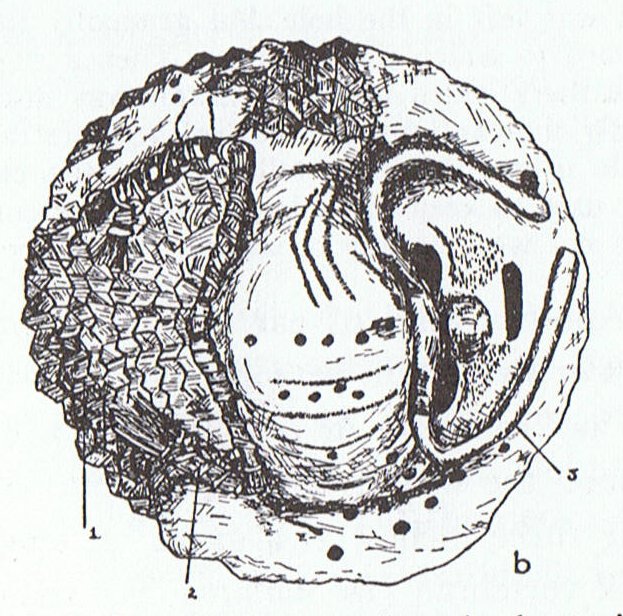|
TRANSLATIONS
Indeed, pictures are more easy to read than words. In Métraux I found a little picture of a manu uru with his comments:
"The nose is narrow and straight and on the same plane as the forehead. The mouth is formed by two parallel raised strips. The oval eyes protrude. The cheekbones are two crescentic prominences ..." Crescents are signs of the moon, I believe, and we remember the same type of signs under the eyes of our example of ua:
The left eye has a bigger dark pupil than the right, and I guess that is in order, because first comes darkness and later on light. In the picture language left seems to correspond to darkness, female, and before, while right means light, male, and later on. The rongorongo texts follow this pattern. We remember Aa4-58 and Aa4-60 respective Hb9-23 and Hb9-25:
Left indicates 'past' (tu'a) and right 'what we see in front of us' (mata). From this perspective it is reasonable to understand Ab1-2 in a new way:
The crescent at bottom corresponds to the crescentic 'prominence' of a cheekbone and the light (hau tea) is located at the level of the eyes. Nose and eyebrows form the middle vertical line respectively the 'roof' of hau tea. The central sun god picture in Tiahuanaco has a similarly formed face, with mouth like a horizontal line and a nose supporting the sky roof - together forming a kind of T (cfr manu uru above):
Continuing with these ideas we recollect the 3 glyphs to be compared:
In Ab1-2 the crescent and the lights above are one and the same, in Ab1-15 another light (different, yet not separated) is onboard, and in Aa4-14 a separation has occurred. Sun has been reborn from mother moon. In Sb2-33 another image possibly tells about how sun is a canoe:
Aa4-14 is located on the sunny side of the tablet and around spring equinox:
Maybe sun is inside the 'uterus' (henua) up to that point. Conception at midsummer + 9 months = spring equinox. Metoro used to call the 'feather crown' in GD19 haú.
Possibly he saw the binding together of the crown as more important than the feathers as such. Possibly he used Tahitian hau = government → the kingdom of the sun. To 'prove' that the normal type of GD19 fundamentally is of the same kind as the oval type, we have evidence in a parallel:
According to my early investigations into this solar calendar the 6th subsequence of glyphs from the beginning could cover the days 66-78, i.e. be located somewhat before spring equinox (day 95). In the 3rd of the 8 moon periods, according to Mamari, we find:
In Ca7-9 the arm is a separate part from the sitting main figure. I commented:
The separation may show the moment of birth, the time when the 'fruit' (Ohua) emerges as a separate entity. In the lunar calendar it may be the full moon which appears, while in the solar calendars it may be the 'full' sun. The 2nd part of the cycle is initiated by the maximum phase, and the black 'eye' becomes white. ... According to a Hawaiian moon calendar: ...in these days the farmers like to plant... anything that bears fruit (hua). The Moon on the night of Hua is rounded like an egg (hua) ... Ca7-15 and other instances of GD19 may tell about how at this time the gods are near, those who wear the fiery headdresses:
At Ab1-15 we have another picture, with moon delivering her baby:
15 is not only the ordinal number in line Ab1, but also the ordinal number of Ca7-15. Furthermore, the number of 'feathers' on the perimeter of that hau is 15. Full moon occurs on the 15th night according to Mamari. In Ca7-16 we can see that full moon is emerging from his (?) mother:
The 'crustacé' reminds us about the crayfish (ura) and also about how in ancient Egypt the sun was imagined to be a scarab: ... First we have the lifting up of the sun:
Hathor emerging through the side of a mountain = the necropolis. (Wilkinson) As I read the picture the sun is depicted as a scarab: There are many species of dung beetle in Egypt, but the great sacred dor or scarab (Scarabeus sacer) is the species which most often is depicted in Egyptian art. This beetle is known for its habit of rolling balls of dung along the ground and then to keep them in tunnels under the surface of the earth for larva food. Larva ... A. † spectre, ghost ... B. insect in the grub state ... L., 'disembodied spirit', ghost', 'mask' ... sense B is due to Linnæus, and is an application of the sense 'mask', the notion being that the perfect insect or imago is not recognizable in the larva (Ray, 1691, had spoken of 'the same Insect under a different Larva or habit' ... (English Etymology) As the young dung beetles appeared to emerge by themselves out of such tunnels the Egyptians worshipped the scarab under the name Chepri, 'he who emerged' or 'he who was created'. Already very early the dor beetle therefore was identified with the god of creation, Atum. The rays on the head of the scarab and the habit to roll a ball of dung in front of himself also made it close at hand to regard it as a symbol of the sun. They also believed that the god Chepri rolled the sun over the sky in the same way ... The necropolis is the mountain and the mountain is the abode of the spirits (larvae). Emerging from 'pits' (rua) in the east is returning from 'the other side' (te rua paiga) ... We also have early in Sunday a picture which presumably depicts a similar stage in the development of the sun:
A dry outer shell protects the soft inner parts of the sun from the watery surroundings when he is taking a rest to rejuvenate himself. The dry shell (paka) of a turtle (hônu) comes to mind as a useful symbol for the sun 'riding the waves':
We must here remember what was written about GD17 in the glyph dictionary:
In Métraux there is an illuminating picture:
It is a hat 'of plaited bulrush covered with painted tapa'. In the area marked 1 a part has been ripped off to show the plaiting below. The front part (right) is delineated by a kind of border the structure of which we recognize from that on the face of the sun god at Tiahuanaco (see earlier above). The eyebrow part of the border has a shape like viri. The right side is longer than the left. At the back of the hat there is a similar border, but here the ends are configured as Y, i.e. at the back side we find the female dark part. In the center there is a shell and possibly the creature is an insect. If we count the 'Y-tail' ends as 2 each we reach the sum 6 for the legs. The head of the creature is protruding in front of the shell, at the same time performing the function of a nose. On the left (female) side we see three wedge-formed lines (ribs?) as if to signal GD46 (po, darkness). There are dots too on the shield, and maybe the insect is a lady-bug. |
||||||||||||||||||||||||||||||||||||||||||||||||||||||||||||||||||||||||||||||||||||||||||||||||||||||||||||||||||
